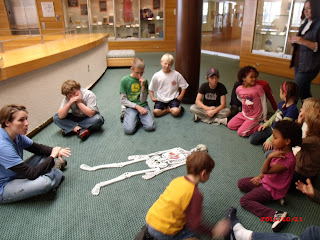
What a wonderful field trip we had the Auburn Cord Duesenberg Museum today! There are so many pictures to share with you.

It began with this wonderful slide welcoming our group to the museum. This is the first time we have had our name on a slide to welcome us.

After explaining a little history about the development of the cars and the inventors, this slide shows the first Auburn produced to the last car produced at the Auburn factory.

Sometimes when someone thinks something is really great, they'll say "It's a Duesy." Did you know that phrase refers the Duesenberg because that was a really great car? We learned something today! (Well, we learned much more than that!)


After the slideshow presentation, each child was given a photo scavenger hunt booklet of 10 cars to find in their museum. They were to write down the year and make of each car. The kids had so much fun exploring the rather large museum. Every time you turned a corner, there was another room. There were so many more cars there than I expected to see. What a great learning experience for the kids.

Throughout the museum, there are signs warning you not to touch the cars. Finally, they get to a car that invited you to sit in the car and feel free to touch!
So, now on to some of the cars we saw:

1926 Model A Duesenberg
This car orginally cost $8,300 when a new Dodge Roadster cost only $855 and a new home would've cost $3,500. There were only a little more than 600 of this model produced. This car originally belonged to the mayor of San Francisco.

1930 Cord L - 29
The cost of this car was $3,195. This was the first mass produced front wheel drive American car.

1932 Auburn 12-160A Coupe
Powered with a Lycoming V-12 that produces 160 horsepower, this car cost $1,545 then dropped to $1,105.
There were other cars on display besides the Auburn, Cord or Duesenbergs:

1929 Lincoln L Brunn Brougham Towncar
There were only 58 of the Brunn Brougham Towncars produced between 1929-30. This car cost $7,200, but you could get a basic Ford at this time for $450.
This particular car was ordered new by Joseph Madden of Omaha, Nebraska for his wife. They owned a dry goods store that was later sold to J.C. Penney. This car was shipped to Florida for their winter use and shipped back to Nebraska when they returned. They sold the car and during WW2 when rationing began, it was put into storage. It changed hands again in 1972 and had a complete restoration. This car now only has 12,000 original road miles on it!

1910 Zimmerman Runabout
This car only cost $840 in 1910. It was owned by John Zimmerman who was company president and later a purchasing agent for Auburn Automobile Company.

This car was E.L. Cord's personal automobile - a 1937 Cord 812.

This car was Frank Lloyd Wright's personal car - 1929 Cord L-29
There was a Haynes - Apperson section of the museum also. Elwood Haynes, from Kokomo, joined with the Apperson brothers to produce automobiles in Kokomo - the factory later became Haynes-Stellite.

This was Edgar Apperson's personal car - 1920 Apperson Model 820. This car sold new for $2,950.

1901 Haynes - Apperson Model A Motor Carriage
The original price was $1,500. This is an extremely rare model.

1900 Eckhart
The Eckhart Carriage Company began on 7th Street in Auburn, Indiana and was incorporated in 1885. Two years later, Frank Eckhart went on the road selling to wholesalers in the midwest states. As the business grew, the Auburn Automobile Company began to take shape.

1904 Auburn
This is the oldest Auburn known to exist.

1930 Auburn 8-125 Sports Sedan
This car may be the ONLY one of it's model left to survive.

1957 Chevrolet

1956 Ford Thunderbird

This is also a Ford Thunderbird (sorry, I don't know the year). My first car was a Ford Thunderbird, but mine looked VERY different from either of these cars!
I had the boys each choose their favorite car. Nicolas's was the one you could sit in:

And Alex's was a 1999 Plymouth Prowler:

The base price for the Prowler is a mere $40,000. (Yep, my son has expensive taste.)


 A couple of ways to make our bones stronger - Vitamin D from the sun and calcium from milk. We can also lift weights.
A couple of ways to make our bones stronger - Vitamin D from the sun and calcium from milk. We can also lift weights.



 Our bones also protect vital organs.
Our bones also protect vital organs.









































